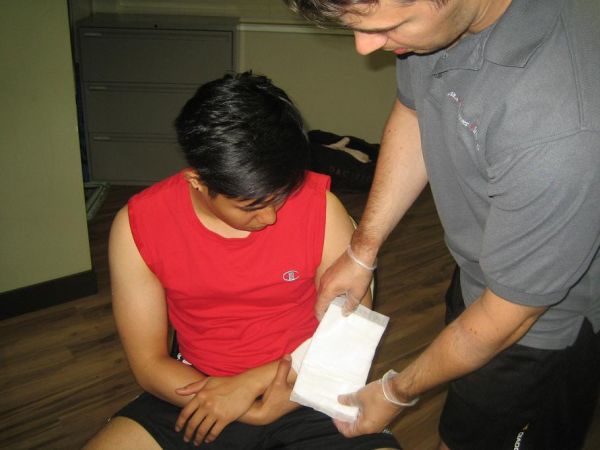by finzy | Jul 26, 2014 | Medical Related
Considering the fact that acute upper respiratory infections are very common not just in Grand Prairie but in other places in Alberta, taking Grand Prairie first aid classes can help residents avoid and manage these problems especially the specific types of diseases which can affect organs in the head. Here are some of these diseases. Sinusitis Also known as rhinosinusitis, sinusitis is the medical term that is used to describe inflamed sinuses. This is the reason why one of its distinct symptoms is facial pain caused by this type of inflammation. It is one of the most common AURI in adults. According to researchers at the Meharry Medical College, it affects 13% of adults each year. Even though it has distinguishable symptoms, a case of acute bacterial sinusitis will only be officially diagnosed if the symptoms are felt by patients for more than 10 days in which the disease may progress into a chronic infection. This is why medical interventions are ordered upon the development of these symptoms even if the patient is not formally diagnosed with acute bacterial sinusitis. Otitis Media A patient is diagnosed with Otitis Media if his or her middle ear is infected or is inflamed. One of the most distinct symptoms of this condition is the feeling of fullness in the ear. Because of the inflammation or the infection, fluid buildup is most likely to occur in the ear which leads to ear discharges. Even though it can be directly caused by specific pathogens such as S. pneumoniae, being previously infected with influenza or other types of AURI can increase its likelihood. This disease...
by finzy | Jul 26, 2014 | Medical Related
According to the Community Health Profile for Grand Prairie that was released in 2013, acute upper respiratory infections (AURI) are the leading causes of hospitalization in the area. This means that this group of diseases affect many Canadians each year. This is why it is important to learn about the traits and characteristics that differentiates these diseases from each other. Here are some of these traits. Locations The main difference among the diseases that are categorized as AURI is that they affect different organs. Rhinosinusitis, otherwise known as sinusitis mainly affect the sinuses and the other organs and membranes in the nose while otitis media affects the ears and the other organelles in this area. Pharyngitis, laryngitis, epiglottitis and tonsillitis affect the tonsils, pharynx and other organs in the mouth and throat while bronchitis and tracheitis affect the organelles, membranes and other structures in the chest cavity aside from the lungs. Some AURI, specifically common colds or influenza, affect more than one area of the body. Symptoms Because of the fact that different diseases affect different organs and locations in the body, it does not come as a surprise that the symptoms differ as well. Sinusitis can cause nose congestion or runny nose while other diseases cannot. Bronchitis and tracheitis can cause chest pains and otitis media can cause ear discharges while other AURI cannot. However, AURI’s have similar symptoms such fever and fatigue. This is why they can easily be misdiagnosed especially by someone who does not have a trained eye. Treatment Certain types of antibiotics and pain relievers work best on certain AURI based on the severity...
by finzy | Jul 26, 2014 | Medical Related
Unknown to many residents, Grand Prairie has a lot of silent killer diseases which are not as highly advertised as cardiovascular diseases and STI’s. This is why many of them think that taking Grand Prairie first aid classes are not important. Here are some of these silent killers which make Grand Prairie first aid training more relevant than ever. Hypertension According to the statistics that was included in the community profile for Grande Prairie which was released by the Primary Health Care Division in 2013, hypertension was the most prevalent disease in the area back in 2010. Apparently, the hypertension rate in the area was even higher than the average hypertension rate in the entire province of Alberta. Based on previous data, researchers and government officials also highlighted the fact that this rate is increasing every year. It also does not help that obesity is still one of the area’s main problems and that heart diseases still have the highest morbidity and mortality rate in comparison to other diseases. Neoplasm Neoplasm, often referred to as tumors or tumor growth, was once the leading cause of deaths in Grand Prairie. in 2010, this position was then taken over by cardiovascular or heart diseases. However, this does not mean that tumors and cancers in general is no longer prevalent and lethal since it is still one of the most common causes of operations in the area. Acute Upper Respiratory Infections In the same statistics that was released by the Alberta Government in 2013, it was revealed that acute upper respiratory infections are the leading causes of emergency room visits in Grande...
by finzy | Mar 11, 2014 | Sudden Emergency
Unknown to many, taking Grand Prairie first aid classes does not simply save the lives of people who need immediate medical attention due to accidents, health conditions and other causes. Taking Grand Prairie classes also helps healthcare professionals provide more proficient services to patients and help the government of a municipality or city manage the proposed health budget for the area more efficiently. Statistics and Definition of Nun-urgent Emergency Visits in Grande Prairie Non-urgent emergency department visits are defined as cases in which a patient visits the emergency department of a hospital for conditions that do not require emergency care. In these cases, the patient will not suffer from adverse reactions or life-threatening conditions even if he or she does not receive care for several hours. According to the Alberta Primary Healthcare Community Profile that was released by the Primary Healthcare Division of the Alberta Government in 2013, 67% of emergency department visits for 2011 and 2012 are semi and non-urgent. This means that in Grande Prairie, more than half of the people who go to emergency departments do not require emergency care. Taking Grande Prairie First Aid to Help Healthcare Professionals Most, if not all hospitals train their healthcare employees who work in their emergency departments to use a triaging system which helps identify cases that need emergent care. Most of these systems give priority to patients who are suffering from airway, breathing and circulatory problems as these are the cases which require immediate attention. However, despite the presence of a triaging system, patients who truly need emergency treatments can still be overlooked especially if the influx of...

by Mikha Canon | Mar 6, 2014 | Featured, First Aid
An avulsion injury is a serious injury that occurs when a soft tissue is forcibly torn away, either partially or completely. The organ commonly affected by this kind of injury is the skin. Medically speaking, an avulsion injury usually refers to surface trauma where all skin layers have been torn away, thus uncovering its underlying structures, such as, subcutaneous tissue, muscle, tendons, or even bones. It is likened to an abrasion, except in its more severe form, as body parts can be partially or fully detached from the body. Avulsion injury is typically caused by trauma. Types of Avulsion Injury There are different types of avulsion injury. These types are the general locations where an avulsion injury can occur, which include: Skin (most common) Ear Eyelid Nail Tooth Nerve (brachial plexus) Periosteal Surgical Causes of Avulsion Injury There are many possible causes for an avulsion injury. These are usually by severe trauma to the skin: Human and animal bites Gunshot wounds Stab wounds Crush injuries Falls, especially those against jagged surfaces Severe burns Motor vehicular collisions and accidents, especially those involving dragging incidents Signs and Symptoms of Avulsion Injury The signs and symptoms of any avulsion injury is dependent on the location and the nature of the injury Minimal to severe bleeding Puncture wounds A body part may be partially or completely removed Mild to severe pain Crushed body tissue First Aid Management for Avulsion Injury First aid treatment and management will depend on the type of avulsion injury. However, the utmost priority is to reduce pain and discomfort of the patient. The following is the general recommendation in...

